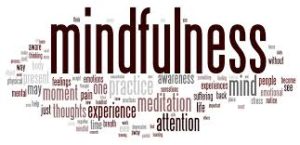 Whoever you are, it’s possible that you could live your whole life in a dream; what the practice of mindful meditation will give you is your actual life. Instead of being driven by forces in the past or anxiety about the future, you can face your life with clarity, relaxation and calm. But, interestingly you are much more likely to get those things out of your meditation practice if you don’t try, if you just allow things to be as they are, then take them as they come, whether you like it or not. -Jon Kabat-Zinn
Whoever you are, it’s possible that you could live your whole life in a dream; what the practice of mindful meditation will give you is your actual life. Instead of being driven by forces in the past or anxiety about the future, you can face your life with clarity, relaxation and calm. But, interestingly you are much more likely to get those things out of your meditation practice if you don’t try, if you just allow things to be as they are, then take them as they come, whether you like it or not. -Jon Kabat-Zinn
“Mindful yoga is a yoga of wholeness that has nothing to do with what your body can or can’t do in any given moment, or how your posture looks. It has everything to do with the sincerity of your effort, with how awake you are in your life and how embodied you are in the only moment in which you are alive — which is always now.” – -Jon Kabat-Zinn
Mindfulness is often likened to a mirror; it simply reflects what is there. It is not a process of thinking; it is pre-conceptual, before thought. One can be mindful of thought. There is all the difference in the world between thinking and knowing that thought is happening, as thoughts chase each other through the mind and the process is mirrored back to us.
The only time that mindfulness can happen is in the present moment; if you are thinking of the past, that is memory. It is possible to be mindful of memory, of course, but such mindfulness can only happen in the present.
Mindfulness is unbiased. It is not for or against anything, just like a mirror, which does not judge what it reflects. Mindfulness has no goal other than the seeing itself. It doesn’t try to add to what’s happening or subtract from it, to improve it in any way. It isn’t detached, like a person standing on a hill far away from an experience, observing it with binoculars. It is a form of participation – you are fully living out your life, but you are awake in the midst of it – and it is not limited to the meditation hall. It can be used on a simple process like the breathing, or on highly charged and unpleasant emotions like fear or loneliness. It can also follow us into the ordinary life situations that make up our day. Eventually, it becomes more a way of living than a technique. From Breath by Breath: The Liberating Practice of Insight Meditation by Larry Rosenberg. 1998. Shambhala Publications.
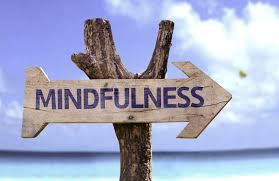 “The heart of skillful meditation is the ability to let go and begin again, over and over again. Even if you have to do that thousands of times during a session, it does not matter. There is no distance to traverse in recollecting our attention; as soon as we realize we have been lost in discursive thought, or have lost touch with our chosen contemplation, right in that very moment we can begin again. Nothing has been ruined, and there is no such thing as failing. There is nowhere the attention can wander to, and no duration of distraction, from which we cannot completely let go, in a moment, and begin again.” Sharon Salzberg, Lovingkindness: The Revolutionary Art of Happiness
“The heart of skillful meditation is the ability to let go and begin again, over and over again. Even if you have to do that thousands of times during a session, it does not matter. There is no distance to traverse in recollecting our attention; as soon as we realize we have been lost in discursive thought, or have lost touch with our chosen contemplation, right in that very moment we can begin again. Nothing has been ruined, and there is no such thing as failing. There is nowhere the attention can wander to, and no duration of distraction, from which we cannot completely let go, in a moment, and begin again.” Sharon Salzberg, Lovingkindness: The Revolutionary Art of Happiness
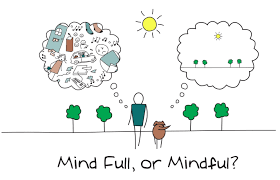 How can we know all of who we are
How can we know all of who we are
unless we take the time to be silently
with ourselves, and to listen to
the many voices of our heart?
- Feldman
Mindfulness “invites us to be willing, over and over again in the face of even our own overwhelm, reluctance, and despair, to turn toward what we most want to turn away from. It invites us to accept what seems beyond accepting and to experiment with embracing the actuality of it with a sense of enormous kindness toward ourselves. This is a practice—one that can only unfold over time.” -Jon Kabat-Zinn, in “When Life Feels Hard.” Sounds True. iBooks
“Between stimulus and response, there is a space. In that space lies our freedom and power to choose our response. In our response lies our growth and freedom.” – Victor Frankl, Author, Psychiatrist, Holocaust Survivor
The crucial factor influencing how well we can respond in any given situation seems to be the level of mindfulness we can bring to bear upon the moment. If we don’t care to be present, unconscious decision-making systems will function to get us through to the next moment, albeit in the grips of (often flawed) learned behaviors and conditioned responses. If, on the other hand, we can increase the amount of conscious awareness present by manifesting mindfulness, we expand the range of our possible responses. Even if disposed to anger, we can choose to act with kindness. This is the essence of our freedom in an otherwise heavily conditioned system. Andrew Olendzki
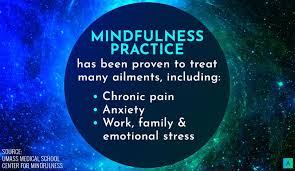 Patience is a hard discipline. It is not just waiting until something happens over which we have no control: the arrival of the bus, the end of the rain, the return of a friend, the resolution of a conflict. Patience is not waiting passively until someone else does something. Patience asks us to live the moment to the fullest, to be completely present to the moment, to taste the here and now, to be where we are. We behave as if the real thing will happen tomorrow, later, and somewhere else. Let’s be patient and trust that the treasure we look for is hidden in the ground on which we stand. Henri J.M. Nouwen
Patience is a hard discipline. It is not just waiting until something happens over which we have no control: the arrival of the bus, the end of the rain, the return of a friend, the resolution of a conflict. Patience is not waiting passively until someone else does something. Patience asks us to live the moment to the fullest, to be completely present to the moment, to taste the here and now, to be where we are. We behave as if the real thing will happen tomorrow, later, and somewhere else. Let’s be patient and trust that the treasure we look for is hidden in the ground on which we stand. Henri J.M. Nouwen
“Dwelling in stillness and looking inward for some part of each day, we touch what is most real and reliable in ourselves and most easily overlooked and undeveloped. When we can be centered in ourselves, even for brief periods of time in the face of the pull of the outer world, not having to look elsewhere for something to fill us up or make us happy, we can be at home wherever we find ourselves, at peace with things as they are, moment by moment.” Jon Kabat-Zinn, Wherever You Go, There You Are: Mindfulness Meditation In Everyday Life
 We had our first snow last weekend and like every year after the first snow I heard lots of clients talking about their achy backs from shoveling. As winter settles in here in Iowa I’d like to challenge you to start thinking of your shoveling duties as part of your movement and fitness routine. After all, walking for 20 minutes or more while you use a shovel to pick up and throw heavy wet snow is work and can be a great way to get some exercise! Like any exercise program though you’ll want to make sure you are doing it properly so that you get the maximum benefits without getting hurt!
We had our first snow last weekend and like every year after the first snow I heard lots of clients talking about their achy backs from shoveling. As winter settles in here in Iowa I’d like to challenge you to start thinking of your shoveling duties as part of your movement and fitness routine. After all, walking for 20 minutes or more while you use a shovel to pick up and throw heavy wet snow is work and can be a great way to get some exercise! Like any exercise program though you’ll want to make sure you are doing it properly so that you get the maximum benefits without getting hurt!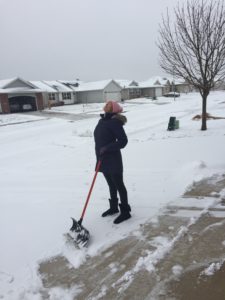 Bend your knees when you pick up the snow to throw it. That moment where you pick the snow up and throw it is an important one. Make sure you end your knees, engage your abdominal muscles and keep your back lengthened!!
Bend your knees when you pick up the snow to throw it. That moment where you pick the snow up and throw it is an important one. Make sure you end your knees, engage your abdominal muscles and keep your back lengthened!!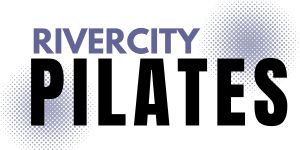
 eep me warmer!
eep me warmer!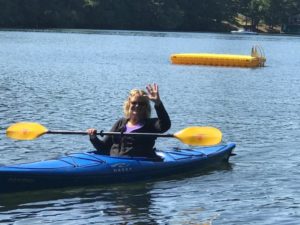 Sarah Sobocinski
Sarah Sobocinski Whoever you are, it’s possible that you could live your whole life in a dream; what the practice of mindful meditation will give you is your actual life. Instead of being driven by forces in the past or anxiety about the future, you can face your life with clarity, relaxation and calm. But, interestingly you are much more likely to get those things out of your meditation practice if you don’t try, if you just allow things to be as they are, then take them as they come, whether you like it or not. -Jon Kabat-Zinn
Whoever you are, it’s possible that you could live your whole life in a dream; what the practice of mindful meditation will give you is your actual life. Instead of being driven by forces in the past or anxiety about the future, you can face your life with clarity, relaxation and calm. But, interestingly you are much more likely to get those things out of your meditation practice if you don’t try, if you just allow things to be as they are, then take them as they come, whether you like it or not. -Jon Kabat-Zinn “The heart of skillful meditation is the ability to let go and begin again, over and over again. Even if you have to do that thousands of times during a session, it does not matter. There is no distance to traverse in recollecting our attention; as soon as we realize we have been lost in discursive thought, or have lost touch with our chosen contemplation, right in that very moment we can begin again. Nothing has been ruined, and there is no such thing as failing. There is nowhere the attention can wander to, and no duration of distraction, from which we cannot completely let go, in a moment, and begin again.”
“The heart of skillful meditation is the ability to let go and begin again, over and over again. Even if you have to do that thousands of times during a session, it does not matter. There is no distance to traverse in recollecting our attention; as soon as we realize we have been lost in discursive thought, or have lost touch with our chosen contemplation, right in that very moment we can begin again. Nothing has been ruined, and there is no such thing as failing. There is nowhere the attention can wander to, and no duration of distraction, from which we cannot completely let go, in a moment, and begin again.”  How can we know all of who we are
How can we know all of who we are  Patience is a hard discipline. It is not just waiting until something happens over which we have no control: the arrival of the bus, the end of the rain, the return of a friend, the resolution of a conflict. Patience is not waiting passively until someone else does something. Patience asks us to live the moment to the fullest, to be completely present to the moment, to taste the here and now, to be where we are. We behave as if the real thing will happen tomorrow, later, and somewhere else. Let’s be patient and trust that the treasure we look for is hidden in the ground on which we stand.
Patience is a hard discipline. It is not just waiting until something happens over which we have no control: the arrival of the bus, the end of the rain, the return of a friend, the resolution of a conflict. Patience is not waiting passively until someone else does something. Patience asks us to live the moment to the fullest, to be completely present to the moment, to taste the here and now, to be where we are. We behave as if the real thing will happen tomorrow, later, and somewhere else. Let’s be patient and trust that the treasure we look for is hidden in the ground on which we stand.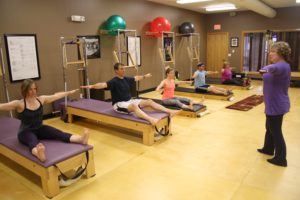 I started a new Beginner Pilates Mat series this week, and at the beginning of class I found myself saying something to this group of new Pilates students that I felt like more people should hear. I told them that they probably wouldn’t be sore after their first class and that’s OK and it’s actually a good thing. I told them they may feel some muscles they haven’t used in awhile and have what I like to call “muscle awareness” but really the last thing I wanted was for me to check in with them in a few days and find out they were so sore it almost hurt move! I could just feel a sense of relief spread through the room when I said this. My guess is that many of my participants who had finally gotten the courage to try Pilates, were already dreading how sore they might be after their first class.
I started a new Beginner Pilates Mat series this week, and at the beginning of class I found myself saying something to this group of new Pilates students that I felt like more people should hear. I told them that they probably wouldn’t be sore after their first class and that’s OK and it’s actually a good thing. I told them they may feel some muscles they haven’t used in awhile and have what I like to call “muscle awareness” but really the last thing I wanted was for me to check in with them in a few days and find out they were so sore it almost hurt move! I could just feel a sense of relief spread through the room when I said this. My guess is that many of my participants who had finally gotten the courage to try Pilates, were already dreading how sore they might be after their first class.